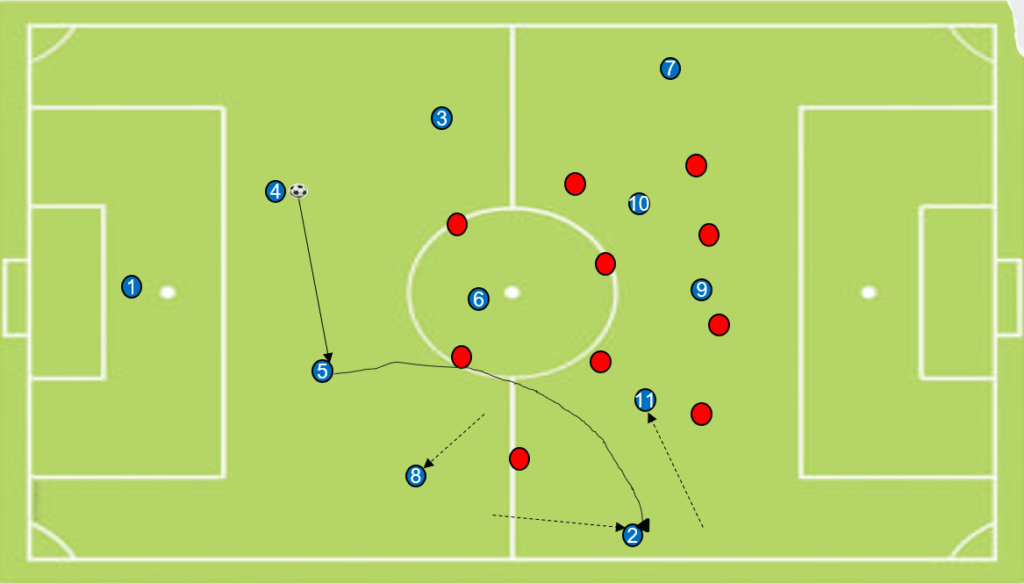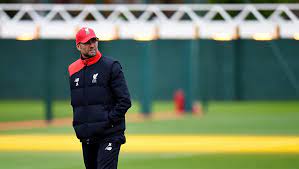The general Football Attacking Principles are crucial for a successful and winning strategy. It is not enough for a team to simply have talented players; they also need to have a plan for how to attack and score goals effectively. In this article, we will discuss how to apply football attacking principles to develop a winning strategy.
Table of Contents
Build up from the Back
One of football’s main attacking strategies is the “building up from the back.” The target is to advance the ball with control, keeping possession while generating scoring opportunities. It entails starting the attack in your own half and moving up the field. This idea helps the team to dominate the game, set the tempo, and create chances to break through the defense of the opposition.
Players need to have high-quality passing and receiving skills and good ball control in order to succeed in build-up play, especially under pressure. Players who can move off the ball to provide support and give the person with the ball options are also crucial. Being the players who initiate the attack, the goalkeeper and defenders are essential to building up play from the back.
The keeper must feel comfortable at handling the ball at their feet and possess accurate ball distribution skills. To help the midfielders and attackers receive the ball and create scoring opportunities, defenders should be able to pass the ball fast and accurately.

Width and Depth
Creating width and depth is another crucial part of the football attacking principles. It involves players spreading out across the pitch to create space and options for passes. This principle can make it difficult for the opponent’s defense to mark individual players, creating confusion and gaps that attackers can exploit.
Creating triangles or diamonds on the pitch is an effective way of achieving this, providing multiple passing options and making it easier to move the ball forward. When executed effectively, this principle can lead to successful attacks and goals.
In order to benefit from width and depth, players must position themselves in ways that create passing opportunities, whether they are rushing into the channels or dropping deep to receive the ball. To maintain the shape and structure of the team, players must be focused on their responsibilities in establishing width and depth. This attacking tactic, which is not just limited to the midfield and attack, allows defenders to push up the field and overlap with the midfielders to assist generate breadth and depth.
Teams can maintain control of the ball, advance it successfully, and generate scoring opportunities by providing space and choices. Coaches should highlight this idea in their training and tactics by emphasizing the importance of width and depth in attacking play.


Speed of Play
Another key attacking principle that can have a big impact on a team’s performance is play speed. Players must quickly switch from defense to offensive, advance the ball quickly, and catch the opposition by surprise. By moving the ball quickly and pressuring their defense to react quickly, teams can use this approach to weaken an opponent’s defense in addition to counterattacks. Teams can create scoring opportunities and put pressure on the defense of their opponents by accelerating the pace of the game.
Players must be aware of their surroundings, predict the next pass, and take positions that open up passing lanes in order to play at a fast pace. The ball should be passed and received promptly by players without sacrificing accuracy. It is also crucial to have quick players who can make runs behind the defense, weakening the defense of the opposition and opening up spaces for further attackers to exploit.
In order to execute this type of football attacking principles, players must work together and communicate well, and they must be aware of their own roles and duties. Teams can develop a quick and dynamic offensive style that can result in winning on the field by concentrating on play pace.
Penetration
An important element included in the general football attacking principles is penetration, which entails players breaking through the defense of the opposition to create scoring opportunities. This idea calls on players to be aggressive, challenging defenders and making daring runs.
Successful penetration can be accomplished by combining individual talent and group effort. Players must possess the technical skill to dribble and pass the ball accurately as well as the game reading and running into open spaces abilities. Teams can create scoring opportunities and apply pressure on the opposing team by breaking through the opponent’s defense.
Players must also be cognizant of the timing and location of their runs in order to successfully penetrate defenses. Making runs into areas where they can receive the ball and open up opportunities for attacks is what is meant by this. Players with the vision to recognize possibilities and the technical ability to complete the pass are also crucial.
Players must also be able to hold onto the ball and not lose it easily, as doing so could lead to a counterattack by the opposite team. Teams can develop a more aggressive offensive style that can overcome even the most tenacious defenders by concentrating on penetration. Teams are capable of successful penetration and the creation of scoring opportunities when individual skill and collaboration are combined in the appropriate proportions.
Below is a video with some examples of penetrating passes the opposition’s lines.
Transition
Transitioning from defense to attack quickly is one of the football attacking principles that many coaches utilize a lot in the last few years, especially after the appearance of Jurgen Klopp in world football. It involves regaining possession and quickly transitioning into an attacking position. This requires players to have a high level of fitness, awareness, and the ability to move the ball quickly. Attacking transition may offer a lot of opportunities for scoring goals.
This principle it enables teams to profit from the opposition’s errors and imbalances. Players must respond appropriately after a turnover or interception in order to transition effectively. Teams need to be able to change rapidly from defending to attacking or from attacking to defending while still playing with a lot of energy.
Players must be aware of their surroundings and plan their next action in order to transition well. This entails making prompt decisions and carrying them out precisely. Each player needs to be aware of their part in the transition process and be able to function as a team. Midfielders must be able to make runs forward and open up scoring opportunities, while defenders must be able to send the ball forward swiftly to midfielders. Attackers need to know when to retreat and defend and when to advance and launch an attack.
The books Coaching Transition Play and Jurgen Klopp: 102 drills by SoccerTutor are great resources to get ideas on how to train the transition to attack.

Conslusion
Applying football attacking principles is crucial for a winning strategy. It requires players to work together and understand the principles of build-up play, width and depth, speed of play, penetration, and transition. Coaches must ensure that their players are aware of these principles and are implementing them during training and matches. By applying these football attacking principles, teams can create a dynamic attacking style that can lead to more goals and, ultimately, more victories.


